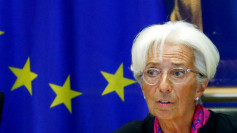It wasn't as bad as Monday's futures predicted. It was far, far worse. And an economic recession is now likelier than ever before.
The Dow Jones Industrial Average went into freefall by more than 3,000 points at one point Monday -- the third worst point loss in history after the Great Depression of 1929 and 1987 Black Monday -- after president Donald Trump revealed the COVID-19 pandemic might last into August. Analysts said it's fortunate Trump's remark was made a few minutes before markets closed at 4:00 p.m. preventing an even greater bloodbath.
The new worst day saw the 30-stock Dow close 2,997 points lower, or 12.9%. The Dow was briefly down more than 3,000 points in the final minutes of trading. The S&P 500 dropped 12% (its lowest level since December 2018) while the NASDAQ Composite closed 12.3% lower in its worst day ever.
Apple shares plunged by 12.9% to $242.21. Bank stocks took a huge hit, with Bank of America falling 15% to $20.44 and JPMorgan Chase dropping 15% to $88.36. Morgan Stanley fell 15.6% to $31.65 while Citigroup dropped 19.3% to $41.19. The big banks Sunday said they were halting their buyback programs to provide capital.
"The rapid spread of COVID-19 across the globe has dramatically heightened investor uncertainty and rocked global financial markets," said strategists at MRB Partners, adding the situation will "get worse before it gets better."
"Looking ahead, the number of active cases is likely to worsen in the near run," they wrote to investors.
Futures predicted the plunge, but not its breathtaking extent. The Dow opened 9.7%, or 2,250 points, lower. The S&P 500 opened down 8.1%. The index hit a circuit breaker after falling more than 7%. Trading was then halted for 15 minutes. The NASDAQ fell 6.1% at the opening.
And the worst is on the horizon with the news on Monday the European Union has shut down its economies and imposed severe measures to cripple the further spread of COVID-19. And the admission by Trump the pandemic might stretch out until July or August as the trading day ended bodes ill for Wednesday's session.
Speaking at the White House coronavirus briefing, Trump said the worst of the COVID-19 outbreak could last until August. He also said the U.S. "may be" heading into a recession.
"The markets are getting no break with yesterday's historic Fed actions and COVID-19 dominating the world's headlines," said Frank Cappelleri, executive director at Instine. "While the news continues to worsen and with the price action doing things we've only seen a handful of other times in the last century, it's nearly impossible to keep things in perspective. We can't argue the facts, and we're dealing with a much bigger issue than just the economy."
Monday's losses sank the Dow 28% from its all-time high in February and the S&P 500 and NASDAQ more than 26% below their records last month. At one point on Monday, the Dow fell 30% from its record.
The sell off was so abrupt and quick trading was halted for 15 minutes shortly after the open. An 8.14% plunge on the S&P 500 triggered a circuit breaker. It was the third time since last week a circuit breaker was triggered to forestall further huge losses.
The massive Monday selloff was predicted by a stunning plunge in futures. Before Monday's open, futures contracts tied to the major averages hit their "limit down" levels, which meant the couldn't trade below that threshold.
Contracts on the S&P 500 fell 5%, rapidly reaching the "limit down" set by the CME futures exchange to prevent huge losses. The limit means no prices can trade below this threshold. Dow futures fared little better, plunging more than 1,000 points. This rapid plunge also triggered the limit down level.
The halt occured during non-U.S. trading hours, or before the 9:30 a.m. ET open of regular trading Monday. Analysts said the limit down rule has been activated multiple times over the past few weeks as investors fled equities over fears the Trump administration is losing the fight against COVID-19.
A rally, however, seems in store Tuesday due to the federal government's assurance of a $50 billion bailout for the shattered U.S. airline industry and the effects of the close to 0% cut in interest rates by the U.S. Federal Reserve and a massive $700 billion quantitative easing program.






